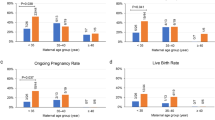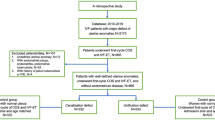Abstract
Purpose
Calcium ionophore treatment is being used in assisted reproductive technology (ART) for cases with previous low fertilization rate or total absence of fertilization after insemination by intracytoplasmic sperm injection or when a specific indication such as globozoospermia is present. As this technique is more invasive and differs from the physiological process of fertilization, a thorough investigation of the health of the children born following this procedure is required. We intent to report the medical outcome of all children conceived following calcium ionophore treatment in our IVF center.
Methods
One-armed descriptive study is performed to report the obstetrical and neonatal outcome of children born after using calcium ionophore treatment during the intracytoplasmic sperm injection procedure in our center.
Results
A number of 237 cycles were included in this study, with 74 pregnancies reported, from which 47 children (31 singletons and 16 twin children) were born. No major malformations were detected in singletons. In twins, three children were diagnosed with major malformations. Minor malformations were present in seven singletons and in one twin.
Conclusions
In conclusion, our results regarding birth characteristics and congenital malformations are within the expected range but, although reassuring, should be interpreted with caution due to the small number of children included.
Similar content being viewed by others
References
Johnson LN, Sasson IE, Sammel M, Dokras A, et al. Does intracytoplasmic sperm injection improve the fertilization rate and decrease the total fertilization failure rate in couples with well-defined unexplained infertility? A systematic review and meta-analysis. Fertil Steril. 2013;100:704–11.
Yeste M, Jones C, Amdani SN, Patel S, Coward K. Oocyte activation deficiency: a role for an oocyte contribution? Hum Reprod Update. 2016;22:23–47.
Jones KT. Intracellular calcium in the fertilization and development of mammalian eggs. Clin Exp Pharmacol Physiol. 2007;34:1084–9.
Murugesu S, Saso S, Jones BP, et al. Does the use of calcium ionophore during artificial oocyte activation demonstrate an effect on pregnancy rate? A meta-analysis. Fertil Steril. 2017;108:468–82.
Sfontouris IA, Nastri CO, Lima ML, et al. Artificial oocyte activation to improve reproductive outcomes in women with previous fertilization failure: a systematic review and meta-analysis of RCTs. Hum Reprod. 2015;30:1831–41.
Van Blerkom J, Cohen J, Johnson M. A plea for caution and more research in the ‘experimental’ use of ionophores in ICSI. Reprod BioMed Online. 2015;30:323–4.
Ozil JP, Banrezes B, Tóth S, et al. Ca2+ oscillatory pattern in fertilized mouse eggs affects gene expression and development to term. Dev Biol. 2006;15:534–44.
Vanden Meerschaut F, Nikiforaki D, Heindryckx B, et al. Assisted oocyte activation following ICSI fertilization failure. Reprod BioMed Online. 2014;28:560–71.
D'Haeseleer E, Vanden Meerschaut F, Bettens K, et al. Language development of children born following intracytoplasmic sperm injection (ICSI) combined with assisted oocyte activation (AOA). Int J Lang Commun Disord. 2014;49:702–9.
Miller N, Biron-Shental T, Sukenik-Halevy R, et al. Oocyte activation by calcium ionophore and congenital birth defects: a retrospective cohort study. Fertil Steril. 2016;106:590–6.
Capalbo A, Ottolini CS, Griffin DK, et al. Artificial oocyte activation with calcium ionophore does not cause a widespread increase in chromosome segregation errors in the second meiotic division of the oocyte. Fertil Steril. 2016;105:807–14.
Bonduelle M, Liebaers I, Deketelaere V, et al. Neonatal data on a cohort of 2889 infants born after ICSI (1991-1999) and of 2995 infants born after IVF (1983-1999). Hum Reprod. 2002;17:671–94.
Heindryckx B, De Gheselle S, Gerris J, et al. Efficiency of assisted oocyte activation as a solution for failed intracytoplasmic sperm injection. Reprod BioMed Online. 2008;17:662–8.
Belva F, De Schrijver F, Tournay H, et al. Neonatal outcome of 724 children born after ICSI using non-ejaculated sperm. Hum Reprod. 2011;26:1752–8.
Santella L, Dale B. Assisted yes, but where do we draw the line? Reprod BioMed Online. 2015;31:476–8.
Borges E, de Almeida Ferreira Braga DP, de Sousa Bonetti TC, et al. Artificial oocyte activation using calcium ionophore in ICSI cycles with spermatozoa from different sources. Reprod BioMed Online. 2009;18:45–52.
Montag M, Köster M, van der Ven K, et al. The benefit of artificial oocyte activation is dependent on the fertilization rate in a previous treatment cycle. Reprod BioMed Online. 2012;24:52152–5256.
Ebner T, Köster M, Shebl O, et al. Application of a ready-to-use calcium ionophore increases rates of fertilization and pregnancy in severe male factor infertility. Fertil Steril. 2012;98:1432–7.
Ebner T, Montag M, Oocyte Activation Study Group, et al. Live birth after artificial oocyte activation using a ready-to-use ionophore: a prospective multicentre study. RBMOnline. 2015;30:359–65.
Nikiforaki D, Vanden Meerschaut F, de Roo C, et al. Effect of two assisted oocyte activation protocols used to overcome fertilization failure on the activation potential and calcium releasing pattern. Fertil Steril. 2016;105:798–806.
Belva F, Bonduelle M, Roelants M, et al. Semen quality of young adult ICSI offspring: the first results. Hum Reprod. 2016;31:2811–20.
Acknowledgements
The authors wish to thank the clinical embryologists and laboratory technologists from the Centre for Reproductive Medicine and to Andrea Buysse from the Centre of Medical Genetics.
Author information
Authors and Affiliations
Corresponding author
Ethics declarations
No additional informed consent was required. The study was approved by the Ethical Committee of the UZ Brussel (B.U.N. 143201732431).
Conflict of interest
The authors declare that they have no conflict of interest.
Rights and permissions
About this article
Cite this article
Mateizel, I., Verheyen, G., Van de Velde, H. et al. Obstetric and neonatal outcome following ICSI with assisted oocyte activation by calcium ionophore treatment. J Assist Reprod Genet 35, 1005–1010 (2018). https://doi.org/10.1007/s10815-018-1124-6
Received:
Accepted:
Published:
Issue Date:
DOI: https://doi.org/10.1007/s10815-018-1124-6




